Dell Vostro 15 3501 review – an entry-level budget option for your business
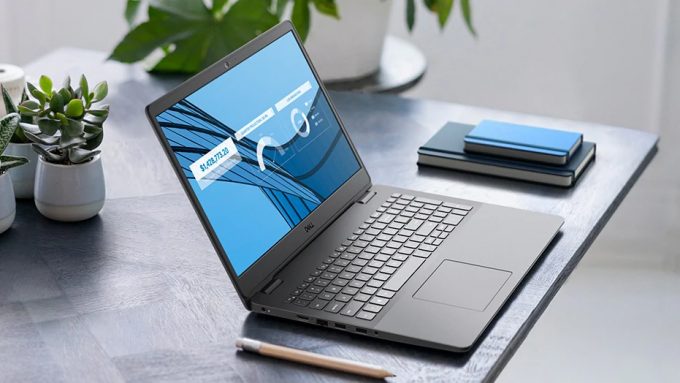 Today we have a budget business notebook, which can be considered as the embodiment of 2020. This is because one can see cost-cutting measures all around it – the design, the build quality, the performance… However, it is a notebook that has to oil your business’ gears, so we have to check it out.
Today we have a budget business notebook, which can be considered as the embodiment of 2020. This is because one can see cost-cutting measures all around it – the design, the build quality, the performance… However, it is a notebook that has to oil your business’ gears, so we have to check it out.
One thing we found interesting is that, currently, this laptop is only offered with the Core i3-1005G1 – a very modest Ice Lake CPU, which has only two cores and four threads. This may very well put it on the trailing edge since some of its competitors are being released with AMD Ryzen 4000U processors, which are superior not only in their core count but in average performance and efficiency.
In terms of displays, Dell is still trying to sell the terrible 768p TN displays, which becomes more and more annoying, given their poor viewing angles, contrast ratio, and resolution. On the other side, you have the option for a 1080p IPS panel, which is pretty much the standard these days.
You can check the prices and configurations in our Specs System: https://laptopmedia.com/series/dell-vostro-15-3501/
Contents
Specs Sheet
- HDD/SSD
- up to 512GB SSD + up to 1000GB HDD
- M.2 Slot
- 1x 2280 PCIe NVMe 3.0 x4 See photo
- RAM
- up to 32GB
- OS
- Windows 10 Pro, Windows 10 Home, No OS
- Battery
- 42Wh, 3-cell, 42Wh
- Body material
- Plastic / Polycarbonate
- Dimensions
- 363.9 x 249 x 18 ~ 19.9 mm (14.33" x 9.80" x 0.71")
- Weight
- 1.90 kg (4.2 lbs)
- Ports and connectivity
- 1x USB Type-A
- 2.0
- 2x USB Type-A
- 3.2 Gen 1 (5 Gbps)
- HDMI
- 1.4
- Card reader
- microSD (SD/SDHC/SDXC)
- Ethernet LAN
- 10, 100, 1000 Mbit/s
- Wi-Fi
- 802.11a/b/g/n/ac/ax
- Bluetooth
- 4.2/5.0
- Audio jack
- 3.5mm Combo Jack
- Features
- Fingerprint reader
- Web camera
- HD
- Backlit keyboard
- optional
- Microphone
- Speakers
- 2x 2W, Stereo Speakers
- Optical drive
- Security Lock slot
- Wedge Lock Slot
All Dell Vostro 15 3501 configurations
What’s in the box?
Unsurprisingly, the packaging is pretty modest. You only get a 45W barrel-style charging brick and some paper manuals.
Design and construction
Despite all the corner-cutting, Dell has provided a fairly portable 15-incher in the face of the Vostro 15 3501. It has a profile of 18-19.9mm and weighs 1.90 kg. Sadly, this is mainly because of the materials used – plastic all over the device. Sadly, it is not really a high-quality one, and thus you get a twisty laptop. Now, the finish of the device resembles stripes on the lid, and is simply matte on the bottom panel, with the base being split in two – the keyboard deck has the stripes, while the palm rest area is plain, rough matte.
Expectedly, the lid doesn’t want to open, when we used a single hand. Once opened, you can see an anti-reflective finish, combined with thin side bezels. Thankfully, there is an HD camera (mediocre quality), and it is located above the display. Yet again, the plastic materials play a role in the lack of stiffness.
When we move to the base, we can start talking about the keyboard. And yep, another cost-conscious unit. First of all – there is a noticeable deck flex. Also, its key travel is average, maybe a bit on the short side, and despite the clickiness of the feedback, it sounds springy. Other than that, it has a NumberPad segment, the Power button is located in the top right corner, and the “Page Up” and “Page Down” keys are crammed into the Left and Right Arrow keys – nothing uncommon these days. Additionally, if you want a backlight, you have to check before making the purchase, because it is an optional feature on the Vostro 15 3501.
Thankfully, the touchpad offers decent gliding and accurate tracking. Although it lacks physical buttons, the embedded ones are pretty okay. Well, yeah, there is a very slight dead zone, before it registers the click, but generally – not a bad unit.
Lastly, if you turn the laptop upside down, you will see the ventilation grill and two speaker cutouts. And as of the warm air – it escapes through the back of the device. At least half of it, to say the least, because some of it gets trapped by the backside of the lid, and gets blown in an upwards direction.
Ports
On the left side, the laptop features a power plug, an HDMI 1.4 port, an RJ-45 connector, two USB Type-A 3.2 (Gen. 1) ports, and an audio jack. Then on the left, there’s the security slot, a USB Type-A 2.0 port, and an SD card reader.
Disassembly, upgrade options, and maintenance
There are 9 Phillips-head screws that need to be undone before you remove the bottom panel. In fact, the two in the back corners are captive, and naturally, lift the edges of the panel, so you can start the prying process from there.
In terms of cooling, we see a relatively thick heat pipe and an average-sized fan.
Thankfully, as a business notebook should – it offers very good upgradability. There are two RAM SODIMM slots, and although Dell officially states it can hold up to 16GB in total, we found it to support 32GB. And when it comes to the storage, there is one M.2 PCIe x4 slot, as well as one 2.5-inch SATA drive bay. Also good, is that it comes with the SATA connector, even though our unit didn’t feature a 2.5-inch device.
Lastly, the battery has a modest 42Wh capacity.
Display quality
Dell Vostro 15 3501 has a Full HD IPS panel with a model number BOE T1WD3-NV15N3D (BOE0819). Its diagonal is 15.6″ (39.62 cm), and the resolution 1920 х 1080 pixels. The screen ratio is 16:9, and we are looking at a pixel density of – 142 ppi, and a pitch of 0.18 х 0.18 mm. The screen turns into Retina when viewed at distance equal to or greater than 60cm (24″) (from this distance one’s eye stops differentiating the separate pixels, and it is normal for looking at a laptop).

Its display has excellent viewing angles. We offer images at 45° to evaluate image quality.

The measured maximum brightness of 273 nits in the middle of the screen and 263 nits as an average for the whole area, with a maximum deviation of 9%. The Correlated Color Temperature on a white screen is 7200K – colder than the sRGB standard of 6500K.
In the illustration below you can see how the display performs from a uniformity perspective. In other words, the leakage of light from the light source.
Values of dE2000 over 4.0 should not occur, and this parameter is one of the first you should check if you intend to use the laptop for color-sensitive work. The contrast ratio is good – 1360:1.
To make sure we are on the same page, we would like to give you a little introduction to the sRGB color gamut and the Adobe RGB. To start, there’s the CIE 1976 Uniform Chromaticity Diagram that represents the visible specter of colors by the human eye, giving you a better perception of the color gamut coverage and the color accuracy.
Inside the black triangle, you will see the standard color gamut (sRGB) that is being used by millions of people on HDTV and on the web. As for the Adobe RGB, this is used in professional cameras, monitors, etc for printing. Basically, colors inside the black triangle are used by everyone and this is an essential part of the color quality and color accuracy of a mainstream notebook.
Still, we’ve included other color spaces like the famous DCI-P3 standard used by movie studios, as well as the digital UHD Rec.2020 standard. Rec.2020, however, is still a thing of the future and it’s difficult for today’s displays to cover that well. We’ve also included the so-called Michael Pointer gamut, or Pointer’s gamut, which represents the colors that naturally occur around us every day.
The yellow dotted line shows Dell Vostro 15 3501’s color gamut coverage.
Its display covers 50% of the sRGB/ITU-R BT.709 (web/HDTV standard) in CIE1976.
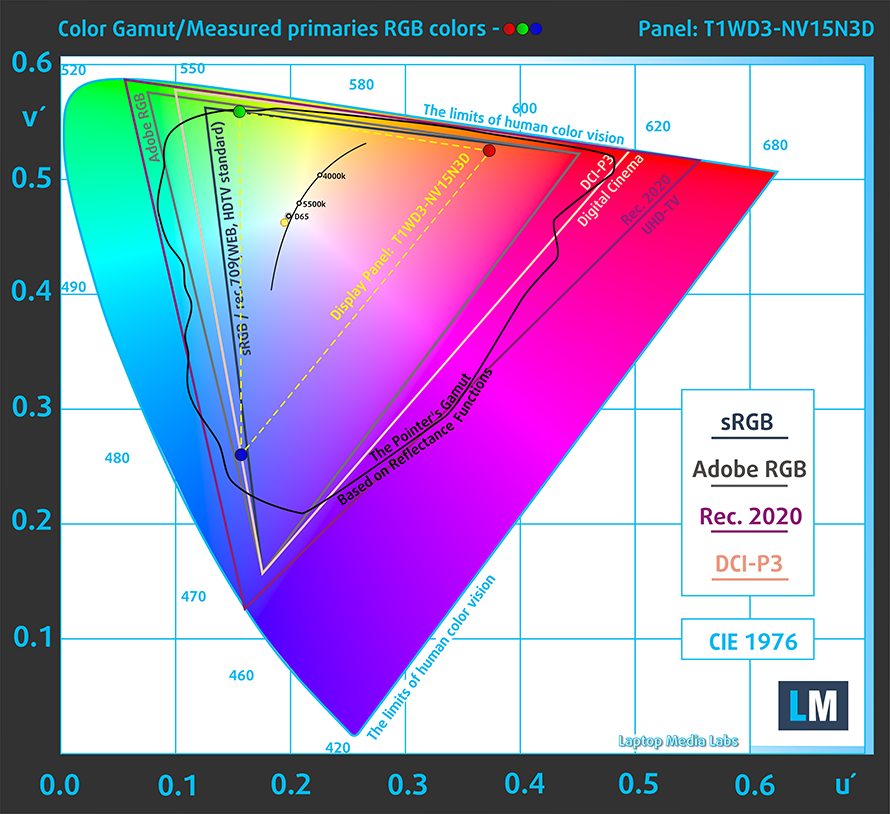
Our “Design and Gaming” profile delivers optimal color temperature (6500K) at 140 cd/m2 luminance and sRGB gamma mode.
We tested the accuracy of the display with 24 commonly used colors like light and dark human skin, blue sky, green grass, orange, etc. You can check out the results at factory condition and also, with the “Design and Gaming” profile.
Below you can compare the scores of Dell Vostro 15 3501 with the default settings (left), and with the “Gaming and Web design” profile (right).
The next figure shows how well the display is able to reproduce really dark parts of an image, which is essential when watching movies or playing games in low ambient light.
The left side of the image represents the display with stock settings, while the right one is with the “Gaming and Web Design” profile activated. On the horizontal axis, you will find the grayscale, and on the vertical axis – the luminance of the display. On the two graphs below you can easily check for yourself how your display handles the darkest nuances but keep in mind that this also depends on the settings of your current display, the calibration, the viewing angle, and the surrounding light conditions.
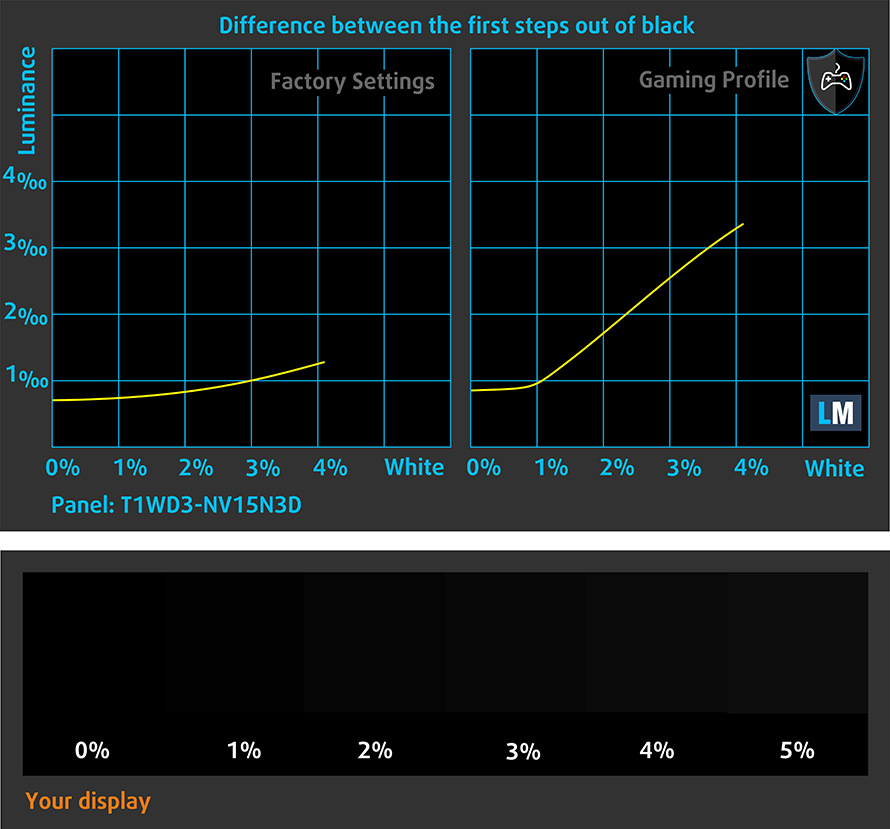
Response time (Gaming capabilities)
We test the reaction time of the pixels with the usual “black-to-white” and “white-to-black” method from 10% to 90% and vice versa.
We recorded Fall Time + Rise Time = 38 ms. The panel is one of the slowest out there.
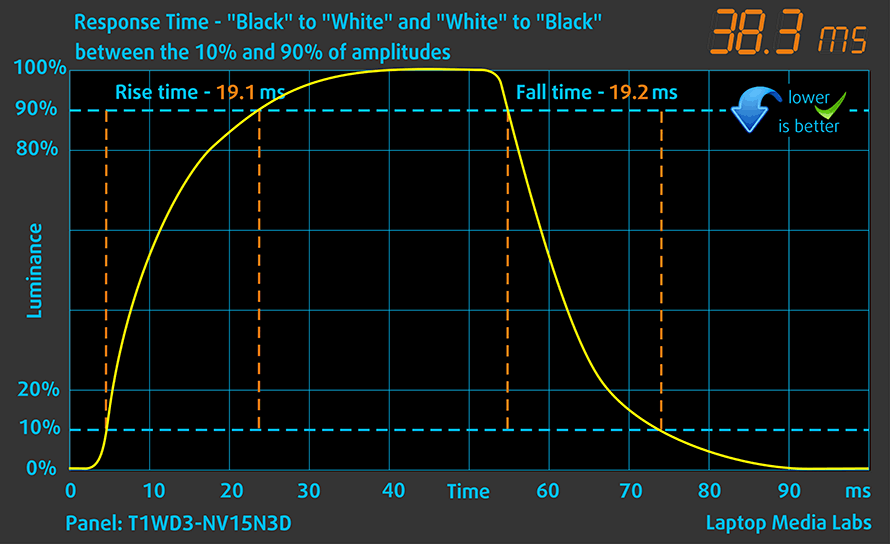
PWM (Screen flickering)
Pulse-width modulation (PWM) is an easy way to control monitor brightness. When you lower the brightness, the light intensity of the backlight is not lowered, but instead turned off and on by the electronics with a frequency indistinguishable to the human eye. In these light impulses, the light/no-light time ratio varies, while brightness remains unchanged, which is harmful to your eyes. You can read more about that in our dedicated article on PWM.
Sadly, the Dell Vostro 15 3501 uses PWM for all brightness levels, except for the maximum. Additionally, the flickerings have a low frequency which is a downside, as well.
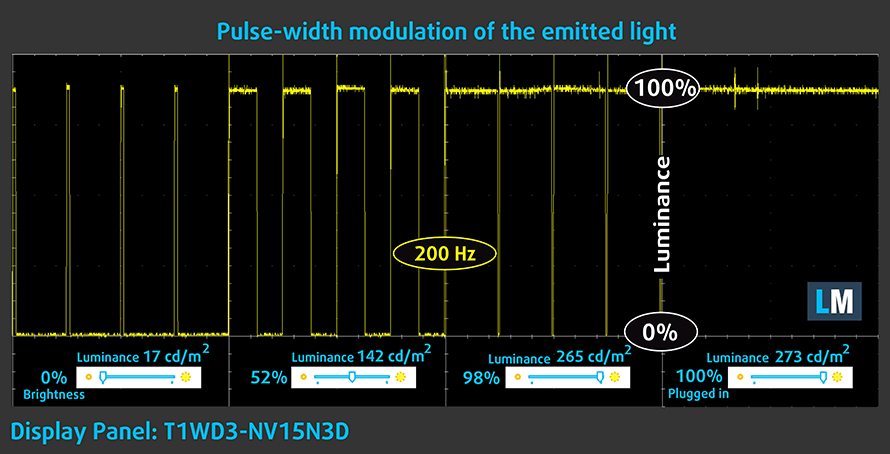
Blue light emissions
Installing our Health-Guard profile not only eliminates PWM but also reduces the harmful Blue Light emissions while keeping the colors of the screen perceptually accurate. If you’re not familiar with the Blue light, the TL;DR version is – emissions that negatively affect your eyes, skin, and your whole body. You can find more information about that in our dedicated article on Blue Light.
Conclusion
Dell Vostro 15 3501’s IPS panel has a Full HD resolution, comfortable viewing angles, and a good contrast ratio. Other than that, it has a modest color coverage (50% of sRGB), and it has a very slow pixel response time. However, the biggest issue here is the aggressive PWM it uses for all brightness levels, except the maximum. On the bright side, our Health-Guard profile completely eliminates the issue.
Buy our profiles
Since our profiles are tailored for each individual display model, this article and its respective profile package are meant for Dell Vostro 15 3501 configurations with 15.6″ FHD IPS BOE T1WD3-NV15N3D (BOE0819).
*Should you have problems with downloading the purchased file, try using a different browser to open the link you’ll receive via e-mail. If the download target is a .php file instead of an archive, change the file extension to .zip or contact us at [email protected].
Read more about the profiles HERE.
In addition to receiving efficient and health-friendly profiles, by buying LaptopMedia's products you also support the development of our labs, where we test devices in order to produce the most objective reviews possible.

Office Work
Office Work should be used mostly by users who spend most of the time looking at pieces of text, tables or just surfing. This profile aims to deliver better distinctness and clarity by keeping a flat gamma curve (2.20), native color temperature and perceptually accurate colors.

Design and Gaming
This profile is aimed at designers who work with colors professionally, and for games and movies as well. Design and Gaming takes display panels to their limits, making them as accurate as possible in the sRGB IEC61966-2-1 standard for Web and HDTV, at white point D65.

Health-Guard
Health-Guard eliminates the harmful Pulse-Width Modulation (PWM) and reduces the negative Blue Light which affects our eyes and body. Since it’s custom tailored for every panel, it manages to keep the colors perceptually accurate. Health-Guard simulates paper so the pressure on the eyes is greatly reduced.
Get all 3 profiles with 33% discount
Sound
Dell Vostro 15 3501’s speakers are fairly loud, and they have a decent quality. Also, the sound is clear of deviations across the entire frequency range.
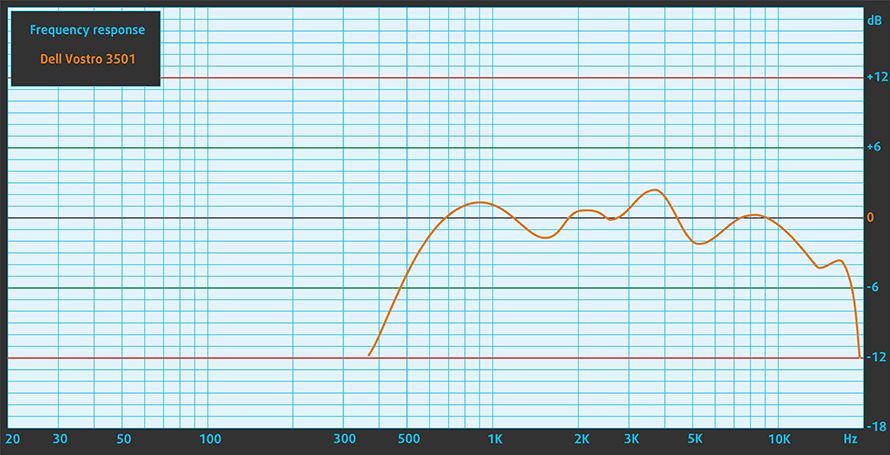
Drivers
All of the drivers and utilities for this notebook can be found here: https://www.dell.com/support/home/en-us/product-support/product/vostro-15-3501-laptop/drivers
Battery
Now, we conduct the battery tests with Windows Better performance setting turned on, screen brightness adjusted to 120 nits, and all other programs turned off except for the one we are testing the notebook with. Despite its unpretentious 42Wh battery, the laptop manages to go through 8 hours and 20 minutes of Web browsing and 9 hours and 3 minutes of video playback.
In order to simulate real-life conditions, we used our own script for automatic web browsing through over 70 websites.
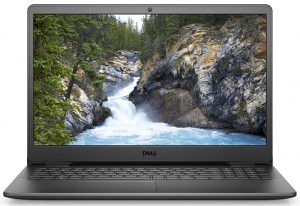
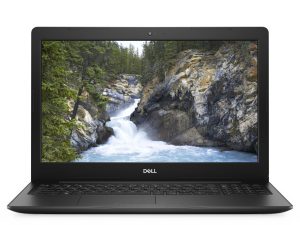
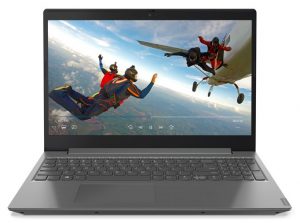
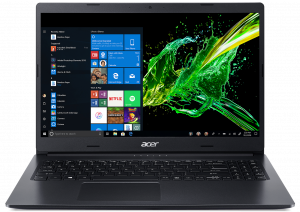
For every test like this, we use the same video in HD.




CPU options
Currently, we were able to find the Vostro 15 3501 only equipped with the Intel Core i3-1005G1.
Results are from the Cinebench 20 CPU test (the higher the score, the better)
Results are from our Photoshop benchmark test (the lower the score, the better)
GPU options
Respectively, the laptop is paired with the integrated Intel UHD G1 Graphics.
Results are from the 3DMark: Time Spy (Graphics) benchmark (higher the score, the better)
Results are from the 3DMark: Fire Strike (Graphics) benchmark (higher the score, the better)
Results are from the Unigine Superposition benchmark (higher the score, the better)
Gaming tests

| DOTA 2 | HD 1080p, Low (Check settings) | HD 1080p, Normal (Check settings) | HD 1080p, High (Check settings) |
|---|---|---|---|
| Average FPS | 54 fps | 34 fps | – fps |
Temperatures and comfort
Max CPU load
In this test we use 100% on the CPU cores, monitoring their frequencies and chip temperature. The first column shows a computer’s reaction to a short load (2-10 seconds), the second column simulates a serious task (between 15 and 30 seconds), and the third column is a good indicator of how good the laptop is for long loads such as video rendering.
Average core frequency (base frequency + X); CPU temp.
| Intel Core i3-1005G1 (15W) | 0:02 – 0:10 sec | 0:15 – 0:30 sec | 10:00 – 15:00 min |
|---|---|---|---|
| Dell Vostro 15 3501 | 3.29 GHz (B+174%)@ 94°C | 3.08 GHz (B+157%)@ 98°C | 2.74 GHz (B+128%)@ 96°C |
| ASUS ZenBook 14 UX425 | 3.29 GHz (B+174%)@ 95°C | 1.88 GHz (B+57%)@ 65°C | 1.92 GHz (B+60%)@ 62°C |
| Acer Swift 3 (SF314-57) | 3.07 GHz (B+156%)@ 89°C | 2.42 GHz (B+102%)@ 79°C | 2.29 GHz (B+91%)@ 74°C |
Indeed, the Vostro 15 3501 shows the best performance out of the three devices we’ve tested, equipped with the Core i3-1005G1. However, this comes with a toll – very high temperature. Interestingly, this seemingly unpretentious processor runs at a 19W power limit at the end of the test.
Comfort during full load
Truly, the laptop isn’t too loud under extreme workload, and the hot inner temperature doesn’t correlate to a hot outer one, which is good.

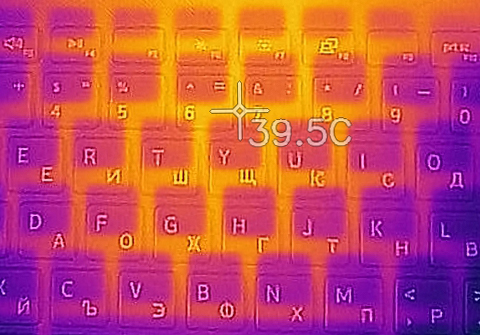
Verdict
Sadly, we have mixed feelings about this notebook. Even when we take its price under consideration, some corner cuttings, are just too obvious. Speaking of obvious, the most prominent one is definitely the build quality. The plastic used here is on the cheap side, and it doesn’t offer a very good rigidity. And while we like the simplistic design, and the quite decent portability, which is a result of the thin and light chassis, we would prefer higher quality materials.
Despite that, there were some regions where we were particularly impressed by the Vostro 15 3501. One of them was definitely the battery life. Although the notebook features a rather small 42Wh unit, we were able to extract 8 hours and 20 minutes of Web browsing and 9 hours of video playback. Exactly what you need from your budget business device. Also good from a business-conscious perspective is that you have an SD card reader, and three USB Type-A ports, although it lacks a USB Type-C one.
Another positive feature is clearly the upgradability. It has two RAM SODIMM slots, one M.2, and one 2.5-inch SATA slot. And unlike other, more expensive devices, this one features its SATA connector, even if your machine is not configured with a 2.5-inch drive.
Dell Vostro 15 3501’s IPS panel (BOE T1WD3-NV15N3D (BOE0819)) has a Full HD resolution, comfortable viewing angles, and a good contrast ratio. Other than that, it has a modest color coverage (50% of sRGB), and it has a very slow pixel response time. However, the biggest issue here is the aggressive PWM it uses for all brightness levels, except the maximum. On the bright side, our Health-Guard profile completely eliminates the issue.
Lastly, there is the performance. While the device performs well for a Core i3-1005G1 notebook, it is still a Core i3. For comparison, AMD has the Ryzen 3 4300U, which is miles ahead in terms of pure performance, and in gaming capabilities.
So, the choice is yours. It has its advantages, and if they outlift the drawbacks in your particular work, it’s safe to get it. And remember – the price is your best friend with this one!
Pros
- Upgradability is on point
- Affordable
- Has an SD card reader
- Respectable battery life
- Has comfortable viewing angles and good contrast ratio (BOE T1WD3-NV15N3D)
Cons
- Covers only 50% of sRGB (BOE T1WD3-NV15N3D)
- Uses aggressive PWM for brightness adjustment (our Health-Guard profile deals with the issue) (BOE T1WD3-NV15N3D)
- Questionable build quality
- Doesn’t offer a USB Type-C port
You can check the prices and configurations in our Specs System: https://laptopmedia.com/series/dell-vostro-15-3501/


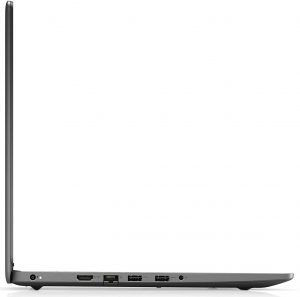
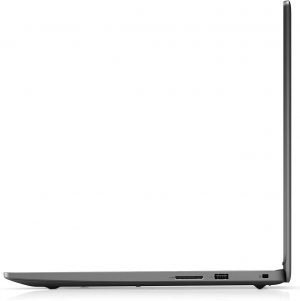
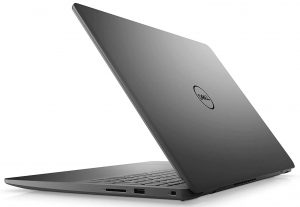
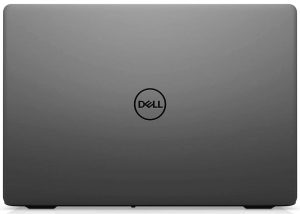
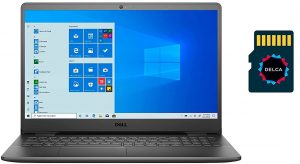
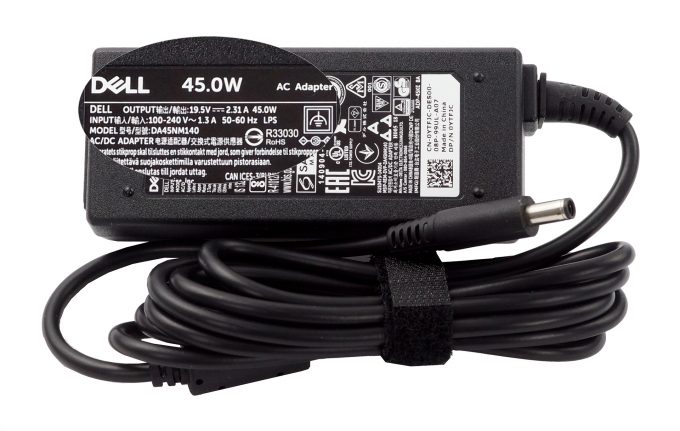
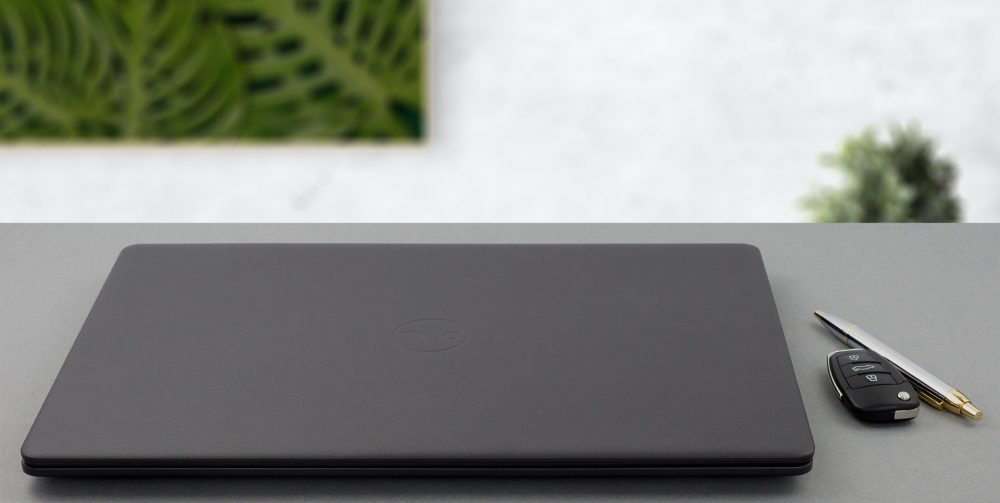
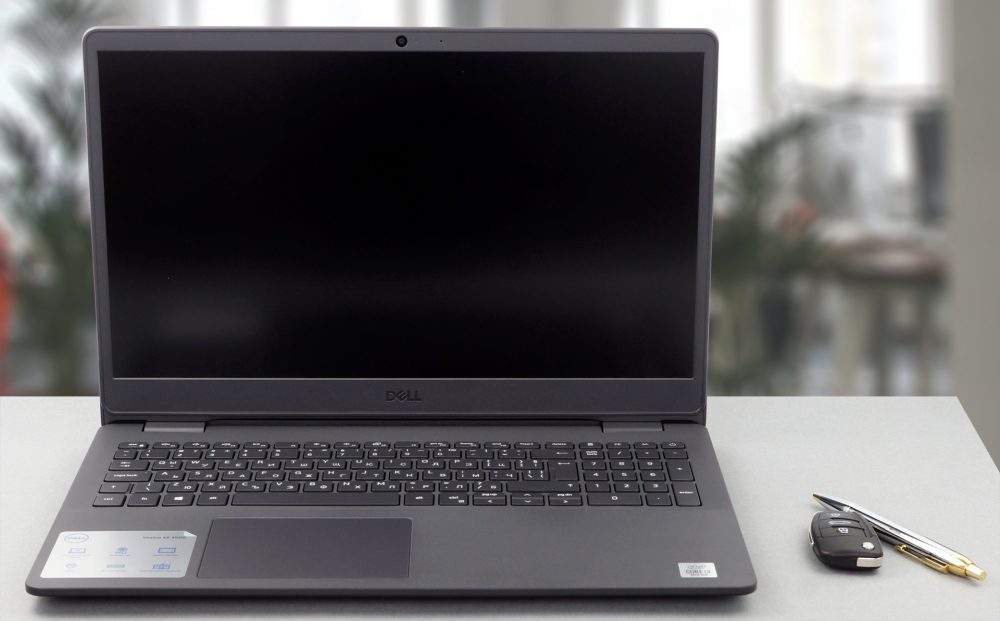
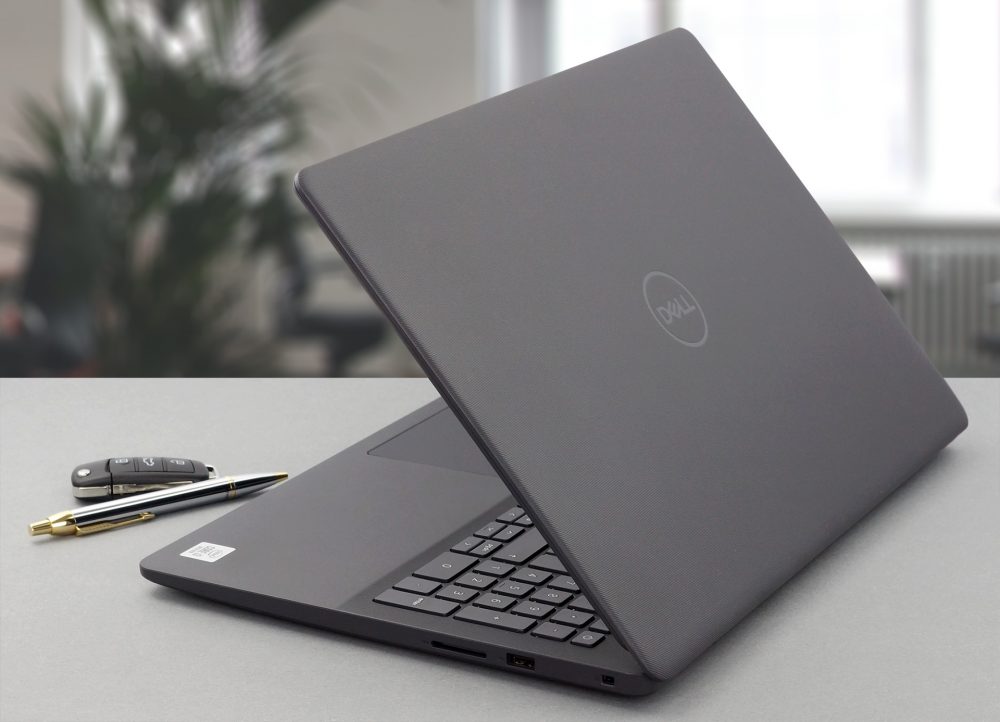
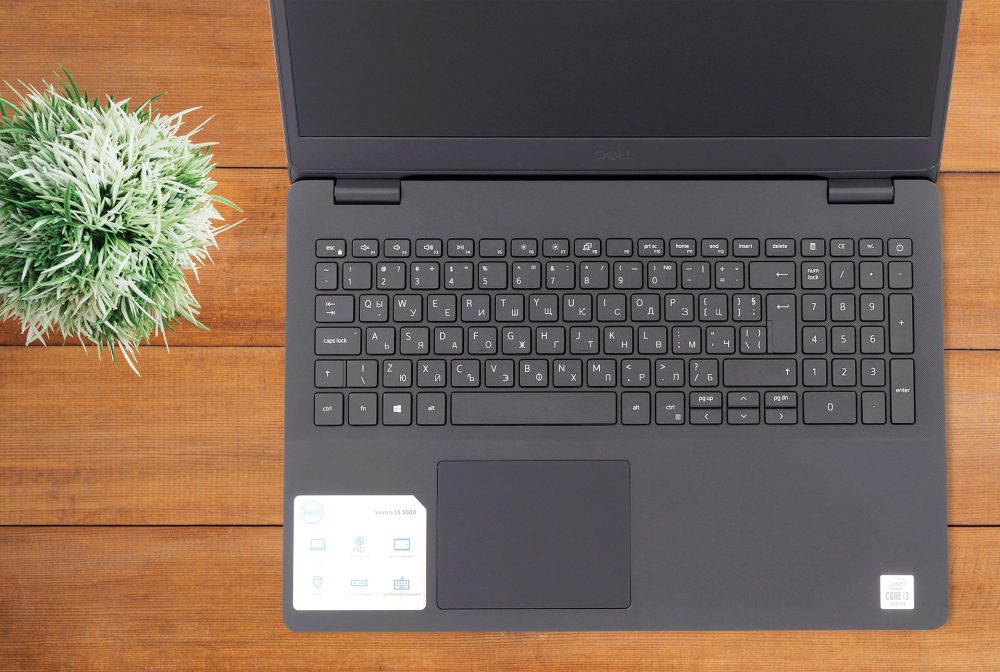



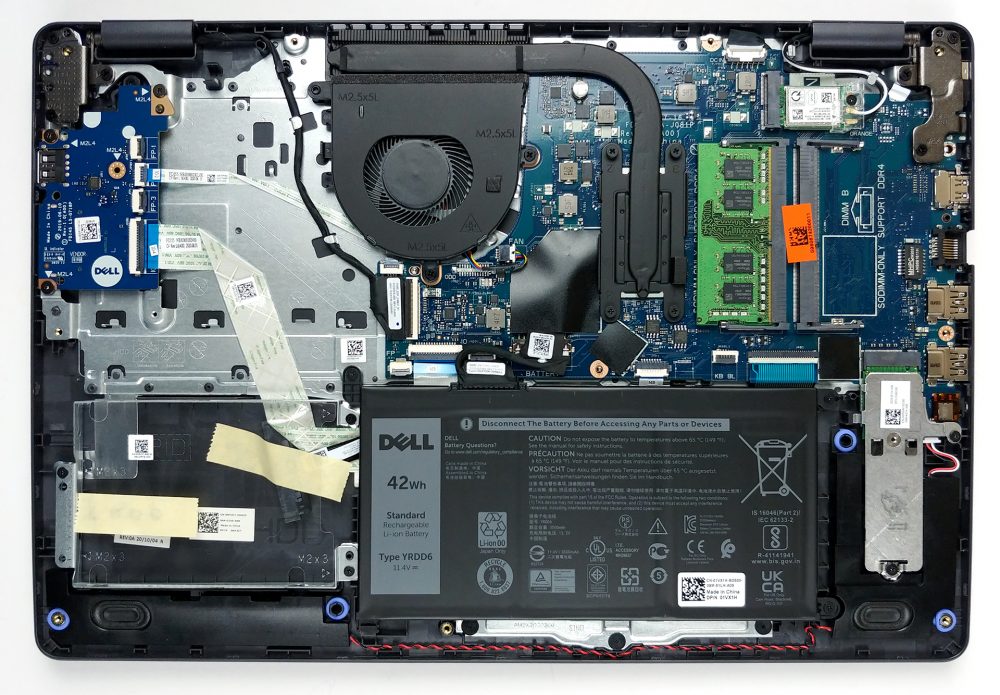
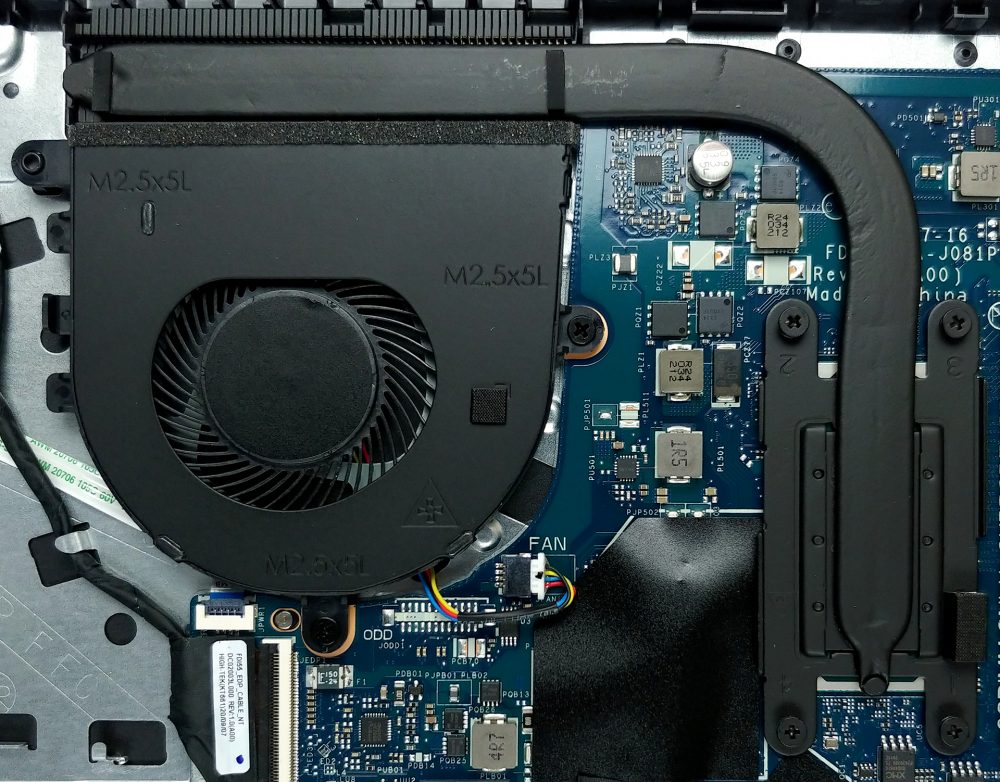
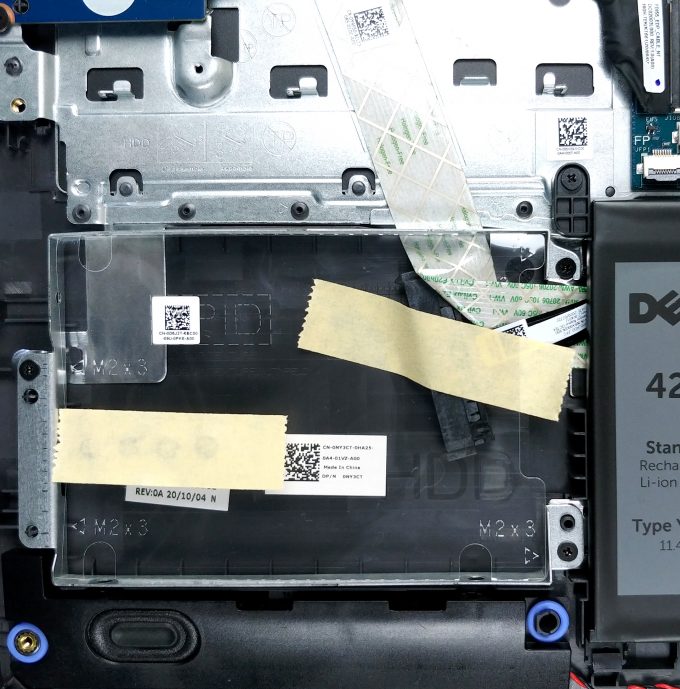
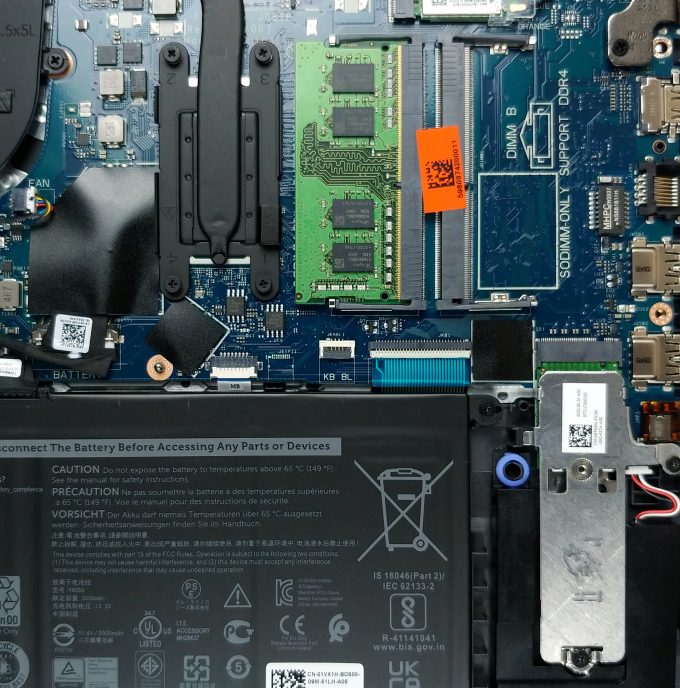
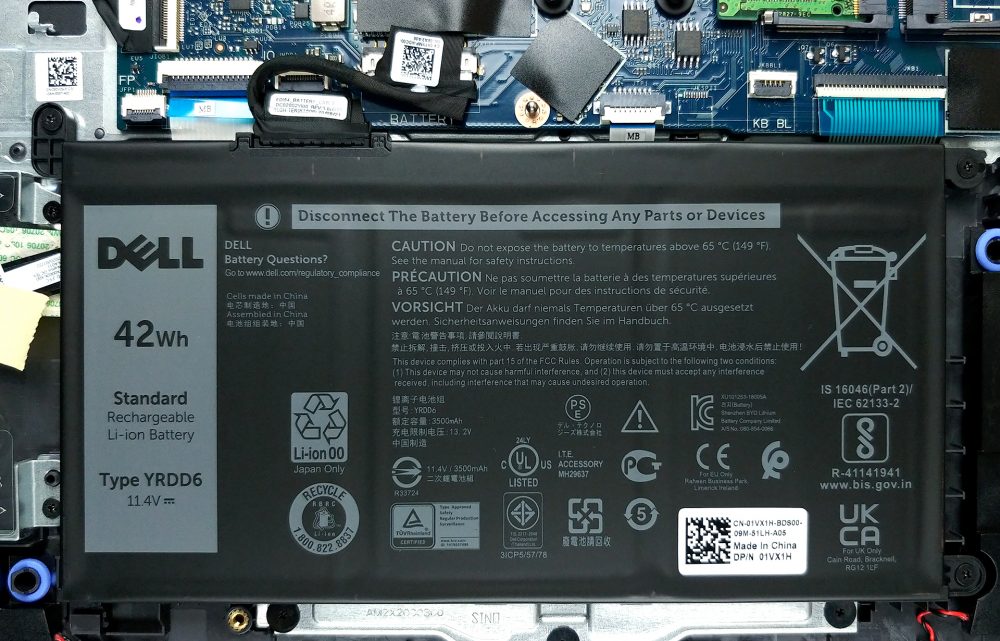
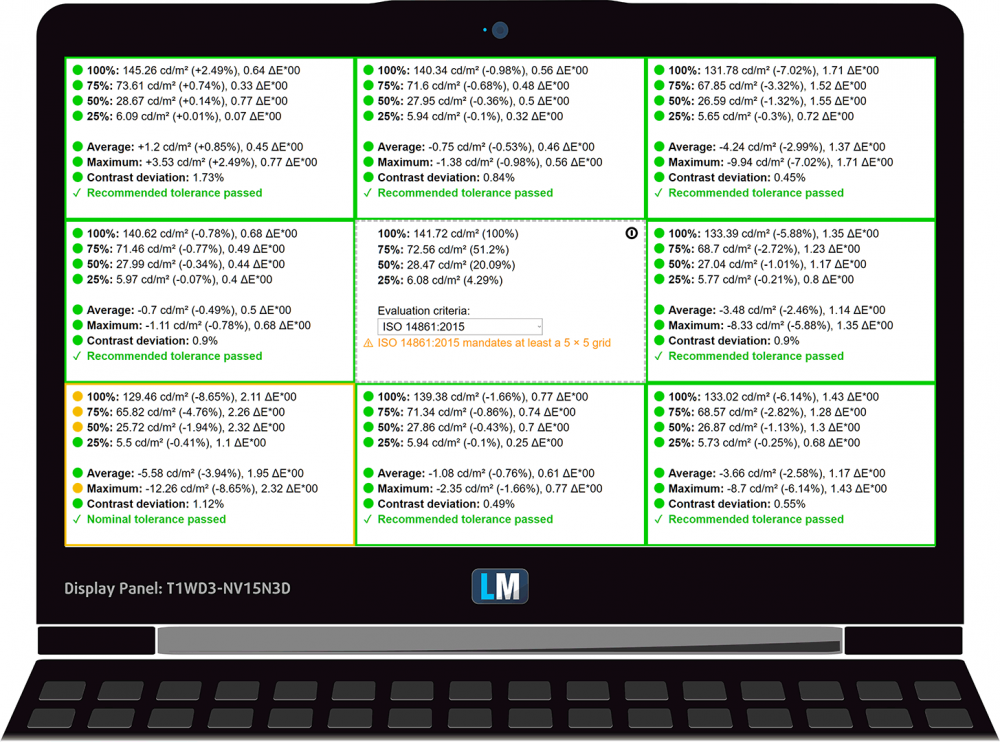

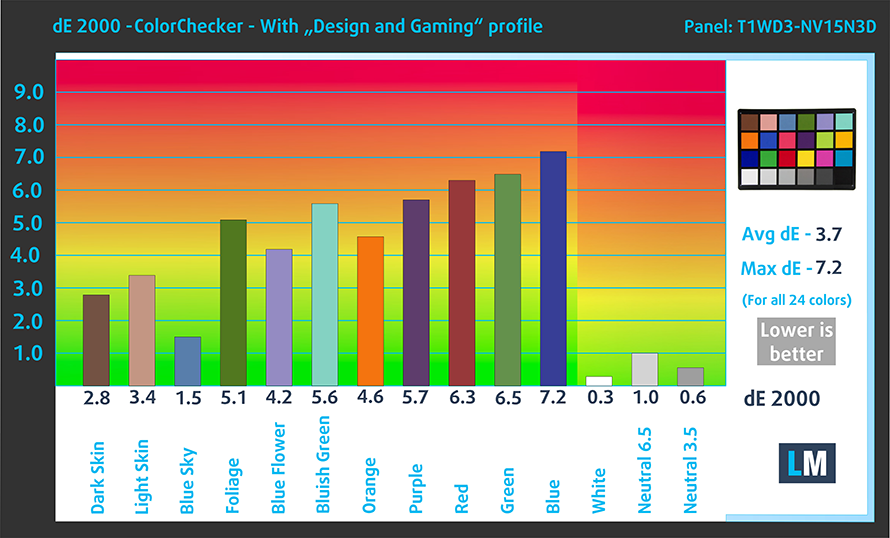

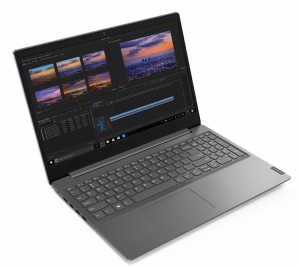
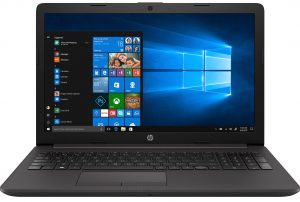









Thanks for efforts and time you obviously put into this review! I am amazed.